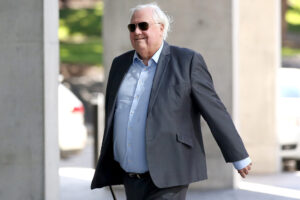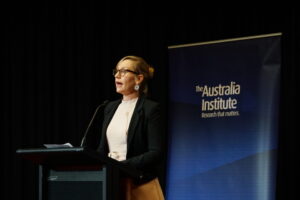Coal train wreck
- Warkworth modelling – you get out what you point in
- Queensland coal train wreck
- Sydney mining economics workshops
- TAI in the media
- Infographic
- Weekly updates from TAI
Warkworth modelling – you get out what you point in
The Warkworth coal mine case, run by the Environmental Defenders Office (EDO and supported by The Australia Institute (TAI) for the village of Bulga prevented Rio Tinto’s plans for a huge mine expansion.
After the court win, the NSW Government changed legislation to allow the project to be reassessed under different conditions.
Now, it’s back. And it’s got a new economic assessment.
The assessment was written by high-profile economist and former head of the Australian Bureau of Agriculture and Resource Economics (ABARE), Brian Fisher, who claims to have used the “most robust approach currently available, through a different methodology to that used in previous assessments.”
Dr Fisher certainly has taken a different approach to earlier assessments. Shrugging off conventional economic practice and NSW Treasury guidelines, he has counted as one of the project’s main benefits its potential to stop workers becoming unemployed.
Many people might be surprised to hear that the employment impacts of a project or policy usually aren’t included in a Cost Benefit Analysis. Analysts assume that workers could get another job at a similar rate of pay without the project in question. In formal economics terms, the assumption is that labour is “priced at its opportunity cost”.
Dr Fisher assumes that workers who might lose jobs on the Warkworth mine will remain unemployed for a long time and then will never again earn wages as high as they do at Warkworth. This allows him to place a much higher value on the mine than you could under conventional assumptions.
The Australia Institute welcomes Dr Fisher’s willingness to buck conventional assumptions around the costs of unemployment. We have argued for years that these costs are not adequately considered by most economic assessment.
For example, executive director Richard Denniss argued in 2008 that reducing tariffs on textiles, clothing and footwear would force layoffs of workers who would have difficulty getting another job, and that this hadn’t been incorporated into the Productivity Commission’s modelling of the policy.
While we support Dr Fisher’s thinking around how projects and policies might cause unemployment, it is hard to find a less appropriate example of where this approach is useful than the Warkworth mine. His assumptions are contradicted by ABS data which shows that employment in coal mining is higher now than it was two years ago.
Instead of looking at ABS data, Dr Fisher has taken his data on mining employment from The Australian newspaper.
Dr Fisher’s models may be the most robust currently available, but like any economic model, it’s a case of garbage-in, garbage-out.
Queensland coal train wreck
Yesterday’s approval of the North Galilee Basin Rail Project could derail other parts of the Queensland coal industry and wider economy. It has all the signs of an economic train wreck for the state, yet the Government has failed to undertake the basic due diligence of Cost Benefit Analysis.
The development of mega-mines like Adani’s Carmichael Project will put huge downward pressure on already weak global coal prices. This is certain to drive down global prices further, causing mine closures and costing jobs in the Surat and Bowen Basin coal mines.
The economic modelling commissioned by another Galilee Project, Clive Palmer’s China First mine, showed that project alone would destroy at least 3000 jobs in other industries, and $1.3 billion in manufacturing activity alone.
The current Queensland coal boom is so big it’s hard to fathom, and it’s raising big risks not just for the climate but also for investors. Queensland’s Galilee basin Special Development Area, an area bigger than the state of Victoria contains mine proposals that would produce 300 million tonnes per year for export, equivalent to one and half times Australia’s direct emissions. Many of these mines are now approved.
The biggest is the Carmichael Mine, a 200 square kilometre project including six open cut and five underground mines. The proponents hope to produce 60 million tonnes of coal each year, starting in 2015. As heard in the Queensland Land Court, by mid-century this would be 4 per cent of the global carbon budget — the total amount we can emit before breaching the 2 degree ‘safety’ threshold. There are also local environmental risks. For example, in late 2013 an independent body raised concerns about modelling used to show the Great Artesian Basin was safe from depletion. Critics of the proponent – Indian coal behemoth Adani – point to a history of environmental damage, regulatory breaches and corruption. Three weeks ago Environment Minister Greg Hunt approved the mine, saying it was subject to “some of the strictest conditions that have ever been imposed”.
While many of the projects have government approvals, their capital is uncertain. The central companies are hugely overleveraged already and having trouble raising more capital for hundreds of kilometres of rail and bigger ports that need large, up-front investment. But investors face big losses, if the coal doesn’t keep flowing over the long term.
World prices are currently seriously depressed due to oversupply. The amount of coal exported from the Galilea basin would depress it further. At least 30 per cent of Australian coal is currently produced at a loss. The big question is what happens next. Global investment bank Citigroup analysts argue “demand is in structural decline as environmental pressures rise and costs of alternative energy sources decline;” just one recent example is the city of Beijing now set to ban coal outright.
China announced its latest step in the “war on pollution” this week, with Beijing Municipal Environmental Protection Bureau official declaring a ban on coal power and the sale of coal in Beijing by the end of 2020, due to its acute health and environmental impacts. While it constitutes a relatively small portion in China’s annual coal use, analysts expect neighbouring provinces to follow suit. The move spells even more woe for the country’s struggling coal industry, given 70 per cent of coal mining companies are already facing losses and solar makers are gaining ground on widespread distributed solar. China’s shift to clean energy also poses increasingly significant challenges for Australia’s coal industry, as NGOs, and credit ratings agencies have been warning.
There are other risks at play. The Abbot Point coal terminal expansion has probably been the highest profile project, because of the risks to the Great Barrier Reef (GBR). The expansion involves dredging and dumping 3 million tonnes of seafloor within the GBR Marine Park. UNESCO criticized the approval and has given Australia 12 months to address threats to the reef, including from dredging, or it will listed the Reef as “in danger”. For this reason numerous international banks have declined to support the project at this stage, including Deustche Bank, HSBC, Barclays and the Royal Bank of Scotland.
Sydney mining economics workshops
Doing great research is only part of the work The Australia Institute does. We also make sure the “research that matters” gets to the people it matters most to, actually getting out there and explaining it to them.
That’s why last Monday night, The Australia Institute held a workshop hosted by executive director Richard Denniss, on mining economics for 100 people at the Sydney Mechanics’ School of Arts.
Huge coalmines and gas fields can have enormous impacts on local communities, farmland, water and the environment in general.
These projects are approved almost entirely on the basis of the claims the coal and gas companies make about jobs and economic benefits. These claims often grossly exaggerate the amount of jobs and economic benefits, don’t talk about who actually gets the benefits, and ignore the costs of the proposed projects. Given the potentially devastating impacts of many of these projects, their assessments should be based on accurate information that doesn’t exaggerate the costs or ignore the benefits.
People trying to protect the environment and their communities from these developments need access to clear and accurate information to challenge the misleading claims made by the companies spruiking their projects.
As it turns out, these claims aren’t that hard to refute, because they are usually so exaggerated.
For instance, although you would never guess it from their PR, the coal and gas industries are very small employers. The coal industry only employs around half of 1 per cent of the Australian (and NSW) workforce, and the oil and gas industry around 0.2 per cent.
The industry likes to talk a lot about the “indirect jobs” it creates. Of course all industries create indirect jobs, they just don’t talk about them endlessly the way the mining industry does. All workers spend their wages in the wider economy. If all industries counted their indirect jobs the way the mining industry does, it would add up to many more times the amount of jobs that actually exist in Australia!
The workshop looked in detail at the real figures on coal and gas jobs, the extent of foreign ownership, the amount of tax and royalties these companies actually pay, and the way big mining projects “crowd out” jobs and businesses in other industries.
The workshop was interactive, encouraging people to talk through the issues, as well as including a question and answer session.
We also provided concise and useful fact sheets and copies of some of our recent reports on the issues, including Fracking the future, Mining in the age of entitlement, and Seeing through the coal dust; coal and the Hunter valley economy. You can find Mark Ogge’s presentation with a bunch of useful graphs and statistics on our website in the Community Resources section.
The feedback was that it was informative, clearly presented, and entertaining. The biggest endorsement we received was that many of the attendees decided to sign up as regular financial supporters of TAI, which is so important for The Australia Institute to be able to continue to do it’s great work. To become a regular supporter click here
TAI in the media
Poor spend most on petrol, figures show, as anger grows at Joe Hockey
Rail line to Great Barrier Reef coal port at Abbot Point wins approval
Between the Lines Newsletter
The biggest stories and the best analysis from the team at the Australia Institute, delivered to your inbox every fortnight.
You might also like
You must be coking! Are new coalmines OK if they help make steel?
Some critics argue we should lay off metallurgical coalmines because they’re used for steel, not energy. But that ignores the big picture.
Who knew Queensland’s richest man is a foreign investor?
Clive Palmer’s controversial legal strategies challenge Australia’s trade agreements and environmental laws, and have profound implications for global climate action, writes Stephen Long.
Removing the Fossil Fuel Industry’s Influence on Politics and Parliament | Senator Larissa Waters
Removing the fossil fuel industry’s influence on politics and parliament is how we change the story and restore trust in government decisions.

